A Salmonella outbreak in Norway, Sweden, and the Netherlands has been linked to contaminated cucumbers from Spain.
The Norwegian Institute of Public Health (FHI) said 72 people are sick in the Salmonella Agona outbreak and 24 have been hospitalized.
People across the country fell sick from the end of October to the start of December. Patients are aged 1 to 88, with a median of 36 years old, and 37 of them are women.
In Sweden, 31 people have been affected, according to the Public Health Agency of Sweden (Folkhälsomyndigheten).
The Netherlands has six confirmed and two probable cases. They are four men and two women with an age range of 5 to 75. All of them have been hospitalized. Epidemiological investigations are ongoing so the link to cucumbers from Spain has not been established.
Only one Spanish supplier involved
Investigations by FHI, local officials, the Norwegian Food Safety Authority (Mattilsynet), and the Veterinary Institute show no new cases have been reported recently which indicates the contaminated product is no longer being sold.
Officials believe the outbreak is over and cucumbers from one Spanish supplier are the likely source. Sick people could have bought the affected product in shops or been served it while eating out.
The Norwegian Institute of Public Health has analyzed 50 patient interviews and purchase information. The agency also carried out a case-control study comparing what patients ate with what a random selection of other people have eaten.
Nearly 90 percent of those infected reported having eaten cucumber in the week before they became ill, but cucumber is commonly eaten in Norway. The case-control study helped to rule out other potential foods as a source of infection in the outbreak.
“Results of the outbreak investigation show that certain batches of cucumber from a Spanish supplier stand out as a likely source of infection. These batches are no longer on the market, and we have not been able to test the product for the outbreak strain,” said Heidi Lange, from FHI.
Wider outbreak
Norwegian importers of cucumbers from the Spanish supplier have intensified sampling as an additional safety measure but Salmonella has not been found.
The Norwegian Food Safety Authority has notified Spanish authorities and other EU countries about the findings from the investigation.
In Sweden, 31 people have fallen ill since the start of November. Patients range in age from 3 to 86 years old and are from 12 different regions in the country. Twenty cases are women and 11 are men.
A trawling questionnaire about food intake in the week before falling ill from 14 cases indicated cucumber as the single most consumed food item. However, statistical evidence is lacking because it is such a commonly eaten product.
Whole genome sequencing has shown patients have the same type of Salmonella Agona, so are suspected of having been infected by a common source.
About Salmonella infections
Food contaminated with Salmonella bacteria does not usually look, smell, or taste spoiled. Anyone can become sick with a Salmonella infection. Infants, children, seniors, and people with weakened immune systems are at higher risk of serious illness because their immune systems are fragile, according to the CDC.
Anyone who has developed symptoms of Salmonella infection should seek medical attention. Sick people should tell their doctors about the possible exposure to Salmonella bacteria because special tests are necessary to diagnose salmonellosis. Salmonella infection symptoms can mimic other illnesses, frequently leading to misdiagnosis.
Symptoms of Salmonella infection can include diarrhea, abdominal cramps, and fever within 12 to 72 hours after eating contaminated food. Otherwise, healthy adults are usually sick for four to seven days. In some cases, however, diarrhea may be so severe that patients require hospitalization.
Older adults, children, pregnant women, and people with weakened immune systems, such as cancer patients, are more likely to develop severe illnesses and serious, sometimes life-threatening conditions.
Some people get infected without getting sick or showing any symptoms. However, they may still spread the infections to others.
(To sign up for a free subscription to Food Safety News, click here.)

